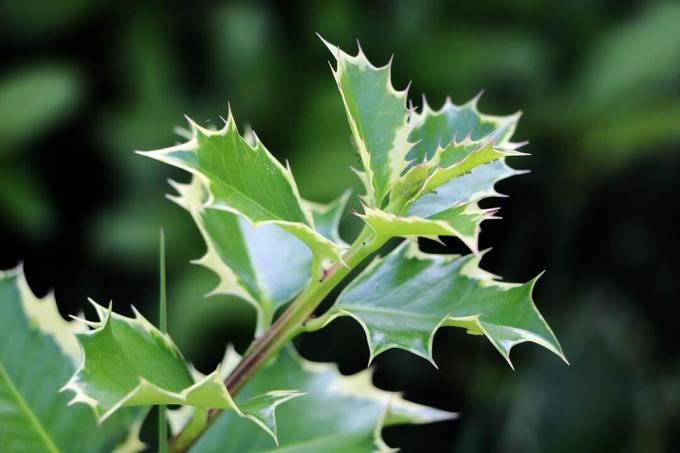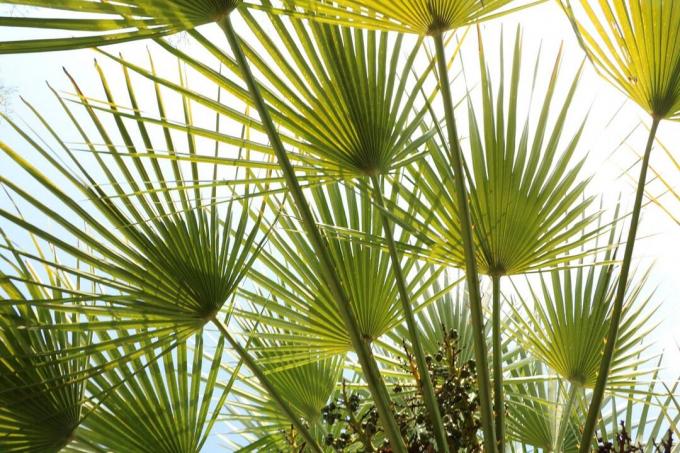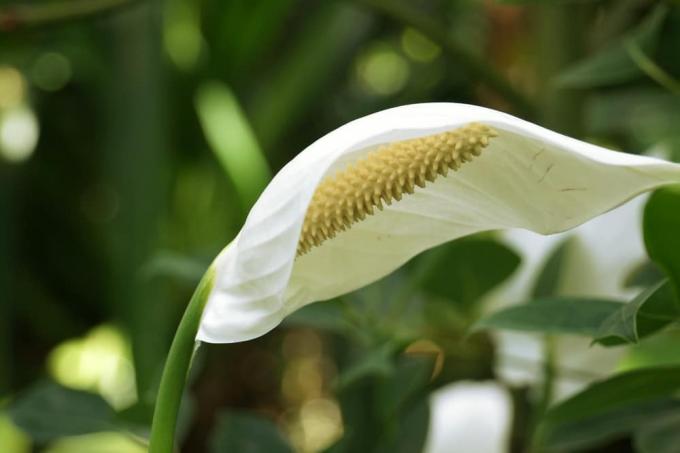
Table of contents
- location and soil
- watering and fertilizing
- cutting / harvesting
- hibernate
- propagation
- pests
- pineapple mealybug
- scale insects
- spider mites
- Conclusion
The real pineapple from the bromeliad family is not only delicious, but also healthy. While the actual plant isn't particularly noticeable, once a fruit forms, it becomes a real eye-catcher. Cultivation and care of pineapples are relatively unproblematic and they are only cut when the fruit is ripe or when the fruit is ripe. Harvest.
The cultivation of a pineapple plant is possible in different ways. It can be grown from seeds, a tuft of leaves, also called rump, or from children that can partially form on the mother plant. However, in contrast to other plants, the cultivation of this tropical plant is quite lengthy and not always promising, which is why a lot of patience and perseverance are required. The pineapple plant grows comparatively slowly. After flowering, the stem of the flower thickens, from which the fruit then develops.
location and soil
The optimal location should be warm, bright and sunny all year round, with several hours of sun daily, whereby blazing midday sun should be avoided, sun in the morning and evening is better evening hours. The brighter the location, the more intense the coloring of the leaves. High humidity is an advantage.
The pineapple belongs to the earth bromeliads and prefers a loose, coarse substrate with a pH value of 5. A substrate that is suitable for bromeliads and consists of equal parts peat and leaf soil is ideal. Instead of peat, a compost-based, mineral and lime-free soil can also be used, which is also somewhat crumbly, loose and, above all, well drained.
Tip:
Repotting the pineapple is rarely necessary, usually only when the pot or the substrate is completely rooted.
watering and fertilizing
- In summer, the pineapple plant is watered regularly.
- If possible, only water with lime-free water.
- Do not pour into the leaf rosette, as is actually common with bromeliads.
- The pineapple is relatively sensitive to this.
- The substrate should be evenly moist.
- It is best to let the top layer of substrate dry before each watering.
- Drought is just as unfavorable for this plant as too much moisture.
- Nutrient requirements of pineapple are moderate to low.
- Fertilize all year round with a commercial liquid fertilizer.
- Administer the fertilizer over the irrigation water.
- Fertilize every two weeks from May to September and slightly less from October.
Tip:
Brown leaf tips are usually an indication of a lack of water in pineapples.
cutting / harvesting
A pruning in the actual sense is not necessary with the pineapple. Only the fruit has to be cut off when the fruit is ripe. It can take 1-4 years for a pineapple to flower for the first time. The fruit develops within 4-8 months and as it ripens, it changes color more and more yellowish, exudes an increasingly intense fragrance and the pulp releases when pressed with a finger after. Now the pineapple can be cut off the stem with a knife. The remaining leaf rosette usually dies afterwards, but should not be thrown away, as it forms small shoots as it dies.
Tip:
Pineapples that ripen in summer tend to be more flavorful than those that ripen in winter.
hibernate
There is not much to consider when overwintering the pineapple. It should continue to be warm and bright, with room temperatures not below 17 degrees and a reduced water and nutrient supply. Due to dry heating air in winter, it is advisable to spray them regularly with water, which can also counteract pest infestation. Specimens that were outdoors should be brought indoors by the beginning of autumn at the latest.
propagation
There are the Possibility to multiply the pineapple. There are three different techniques here:
- from a tuft of leaves
- by sowing the seeds
- by children formed from the mother plant
pests
In order for the pineapple to do well, it must be checked regularly for pests.
pineapple mealybug
The pineapple mealybug is the main carrier of the so-called pineapple wilt. It can cut off the water supply inside the plant, cause the plant to wilt and the fruit to rot at the base. The leaves often show striped discoloration. Ants are often responsible for the transmission of the pineapple mealybug, because they protect the pest colonies from predators, especially when the pineapple is outdoors. In order to combat this pest effectively, the ants must first be kept away or be fought. Natural predators such as chalcid wasps, gall midges and ladybugs can then be used to combat them.
scale insects
A scale infestation can be recognized by small, dark, high-curved shields, especially on leaf veins and stems. In the case of an advanced infestation, the leaves and flowers become stunted, discolored and the leaves fall. If an infestation is discovered, affected plants should be isolated from others as quickly as possible to prevent them from spreading. Suitable systemic agents are commercially available in the form of sprays for combating. If you want to do without such agents and rely on biological control, you can use ladybugs or parasitic wasps against the scale insects and their larvae. Regular spraying with water can help prevent an infestation.
Tip:
Scale insects should not be scraped off the plant, because they usually sit under the scales larvae that have already hatched, which are then distributed over the plant and thus spread further can.
spider mites
An infestation with spider mites shows up as fine white webs, especially in the leaf axils. It is usually the result of low humidity. To combat it, first rinse the plant thoroughly with a strong jet of water. Then you put them dripping wet in a plastic bag, close it and leave the pineapple in it for 3-4 days. The humid microclimate under the film usually kills the pests.
Conclusion
Growing a pineapple is relatively unproblematic as long as you take a few small things into account. It is easiest to grow from a tuft of leaves or buds. However, it can take some time to root and not every attempt is crowned with success. It can also take up to 4 years for the first fruit to develop. But with a bit of luck, the long wait will be rewarded with a delicious, self-harvested pineapple.
 garden editorial
garden editorial I write about everything that interests me in my garden.
Learn more about Exotic Plants

Holly, holly: care from A to Z
The European holly is one of the evergreen plants. It reaches a height of up to five meters and is ideal as a Christmas decoration or garden shrub. The native, although rarely occurring plant is the only native representative of the Ilex family and is particularly easy to care for and robust.

Dwarf palm, Chamaerops humilis: care instructions
The dwarf palm remains small enough that it can also be cared for in the room. However, it also cuts a fine figure in the garden. You can find out here how it is maintained and what needs to be considered.

Dwarf date palm, Phoenix roebelenii: Care from A-Z
The dwarf date palm (Phoenix roebelenii) is a particularly small, actually the smallest palm species of its genus. But that doesn't make them any less decorative. It is the most filigree and elegant date palm and hardly grows higher than one meter.

Growing vanilla plants: 11 tips for care
The vanilla plant is truly exotic in Central Europe and cannot be found in every garden. Vanilla planifolia forms the aromatic pods for which the plant is known. The cultivation of a vanilla plant is easily possible with the right care tips.

Kangaroo Paw: Caring for the kangaroo plant
Kangaroo paws are exotic plants native to southwestern Australia. Considering the care instructions, Kangaroo Paw can also thrive in Central European conditions. Maintenance requires a little more effort. If the plant gets enough attention, it will thank you with magnificent inflorescences.

Einblatt, Spathiphyllum: care from A to Z
Because of simple! The single sheet draws everyone's attention with its extravagant appearance. The imposing flower gives sophisticated rooms that certain something. If the houseplant is in the right place, hardly any care is required. The breeder can find out here what demands Spathiphyllum places on their location.



